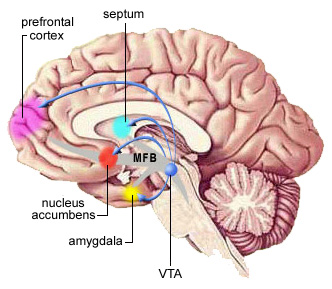


|

|
|
THE ISLAND
Part I:
Part II: |
THE ISLAND SYNDROME Part 2: A Link Between Biology and Technology (September 15, 2010)
The "pleasure center" is a general term for a system within the brain that, when stimulated, creates a sensation of, well, pleasure. The existence of a pleasure center was first hypothesized in 1954 by two Canadian researchers at McGill University, James Olds and Peter Milner. In December of that year, Olds and Milner published a classic paper describing an experiment in which they implanted thin needles with electrodes into various areas within the brains of rats, one needle per rat. Each rat was able to press a lever that would send a small electric current through the needle, thereby stimulating a specific part of its brain.[5] For the experiment, Olds and Milner used 15 male rats, all of whom were given 6-12 hours of time during which the electrode could be activated by pressing the lever. Six of the 15 rats were fortunate enough to have their electrode inserted into an area that created a good feeling when turned on. On the average, these 6 rats ended up pressing the lever more than 81 percent of the time. One rat — unfortunately, history does not record his name — distinguished himself by pressing the lever 92 percent of the time. Olds and Milner thus concluded: "There are numerous places in the lower centers of the brain where electrical stimulation is rewarding, in the sense that the experimental animal will stimulate itself in these places frequently and regularly for long periods of time if permitted to do so." These specific areas of the rats' brains came to be known as the "pleasure center", and subsequent research revealed that similar areas exist in the human brain.[6] Modern thinking now considers the human pleasure center to be a sophisticated system of connections culminating in a small collection of neurons called the "nucleus accumbens" or NAcc (see the figure below). The NAcc plays a crucial role with respect to pleasure, reward, laughter, addiction, and (interestingly enough) the placebo effect.[7] The main connection to the NAcc comes from another area called the "ventral tegmental area" or VTA, via a group of nerve fibers known as the "medial forebrain bundle". The connections between the VTA and the NAcc are mediated by the neurotransmitter dopamine. (Note: We all have two of these systems, one on the right side of our brain and one on the left.)
If your ventral tegmental areas send a small
amount of dopamine into both your nucleus
accumbens, you are going to feel good.
Put simply, if your ventral tegmental areas send a small amount of dopamine into both your nucleus accumbens, you are going to feel good. If your VTAs send a lot of dopamine, you are going to feel very good. This is what happens when someone uses "recreational" drugs such as cocaine, amphetamine and heroin,[8] marijuana and alcohol,[9] and so on. It's also what happens when you have an orgasm.[10] And, as you will see, it is this system that also causes people to become addicted to text messaging and online pornography. (By now, the connection between biology and technology is probably becoming apparent.) Below is a drawing showing the most important connections in the human pleasure center. To orient you: As you look at the drawing, the front of the brain is on your left; the back of the brain is on your right. This particular drawing shows a cross–section view of the brain, a bit to the right or left of the midline. (As I mentioned, there are two sets of structures, one on each side of the brain.) 
Notice how the ventral tegmental area (VTA) connects via the medial forebrain bundle (MFB) to the nucleus accumbens (NAcc). This connection is mediated by the neurotransmitter dopamine. Activating this connection creates the sensation of pleasure. Above the NAcc, you will see another small area called the septum, also a part of the pleasure center. In the rat experiment I mentioned above[5] the septum was the area that, when stimulated, caused the rats to push the lever repeatedly. (Think about this for a moment.) The VTA also connects to many other parts of the brain including (as you can see in this drawing) the prefrontal cortex. The prefrontal cortex is intimately involved with high-level decision-making, intelligence, and personality.
© All contents Copyright 2025, Harley Hahn
|
THE ISLAND A Link Between
|
||||||||||||||||||||||||||||||||||||||||||||||||||||||||||||||||||||